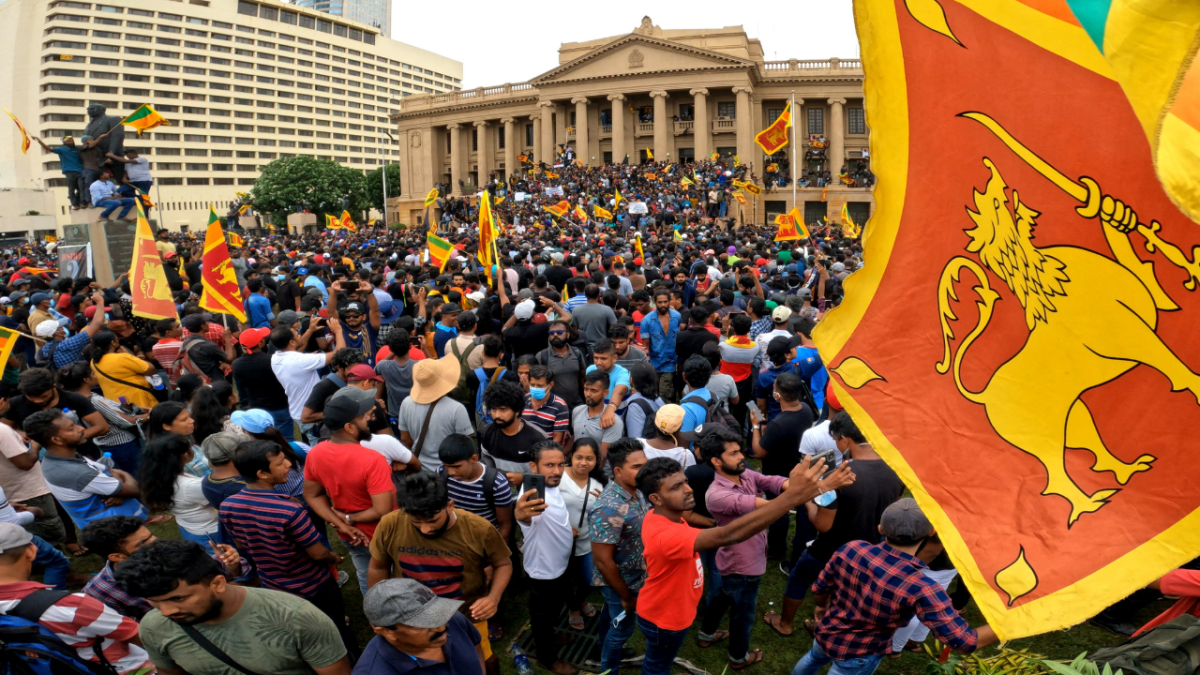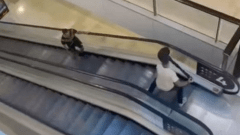
For most of 2022, Sri Lanka has been running extremely low on supplies of petrol, gas, medicine and food. This has resulted in the country’s worst economic crisis since gaining independence from the British Empire in 1948. On Saturday night, Sri Lanka’s Prime Minister and President both promised to resign after continued protests as per the ABC.
On Saturday night, protesters stormed the mansions of Prime Minister Ranil Wickremesinghe and President Gotabaya Rajapaksa who fled under military protection on Saturday as per Times Of India.
Protesters could be seen swimming in the president’s luxury backyard pool in a chilling example of the current wealth gap between Sri Lankan elites and working class citizens.
Images also showed protesters sitting on the President’s couch, taking a shower in his bathroom and lying on his bed.
During the protests, the residence of the PM was also set ablaze.
Sri Lankan protesters stormed the residence of the President and are swimming in his pool pic.twitter.com/qbVFgIAG5f
— Liam (@Hezbolsonaro) July 9, 2022
Sri Lanka citizens chilling in their president’s residence. 😂😂 pic.twitter.com/lwWDpyXdSG
— Dr. George (@GeorgeAnagli) July 9, 2022
The president’s palace in Sri Lanka now belongs to the people. pic.twitter.com/oscI7mRPta
— RadioGenova (@RadioGenova) July 9, 2022
Protesters have broken into the private residence of Prime Minister Ranil Wickremesinghe and have set it on fire – PM media. #DailyMirror #SriLanka #SLnews pic.twitter.com/tpjQob9p5j
— DailyMirror (@Dailymirror_SL) July 9, 2022
The PM and President attempted to cancel the protests on Friday by enforcing a curfew. However, opposition politicians and lawyers deemed it illegal.
Thousands of protestors were later seen occupying the office of the president in the nation’s capital Colombo.
Colombo, Sri Lanka right now. The Presidential Palace has been stormed, President Gotabaya Rajapaksa is said to have fled. Unbelievable scenes. Live reports on @IndiaToday: https://t.co/p6JV6FzCub pic.twitter.com/8zlJdBfN2P
— Shiv Aroor (@ShivAroor) July 9, 2022
Protestors Occupy President’s Office in Colombo, Sri Lanka#lka #SriLanka #SLnews #News1st #ProtestLK #CrisisLK #EconomyLK #SriLankans #Occupy #PresidentOffice #GotaGoGama #Aragalaya #Eng. pic.twitter.com/JiPcXYHiiX
— Newsfirst.lk Sri Lanka (@NewsfirstSL) July 9, 2022
OMG Sri Lanka!! 😍
What an amazing nation. 💪#SriLankaProtests pic.twitter.com/SJ9mz2ltKn— Mariam’s Madness (@MaddyWithKhan) July 9, 2022
Earlier this month, the entire Sri Lankan cabinet resigned except the president and the prime minister.
So how did this all start and what’s going to happen to the South Asian nation?
What caused the economic crisis in Sri Lanka?
Economic experts have said the crisis was years in the making and was driven by government mismanagement, but was accelerated and magnified by the pandemic and other unforeseen events.
The Sri Lankan government during the last decade has borrowed a lot of money to fund public services and put the country in a lot of debt.
In the same timeframe the country has suffered several major blows to its economy including natural disasters and the 2019 Easter bombings that killed hundreds of people at hotels and churches.
When elected in 2019 President Gotabaya Rajapaksa promised tax cuts in an attempt to put more money in people’s pockets and stimulate the economy.
But then the pandemic hit and the country’s lucrative tourism and foreign worker industries were pretty much wiped out.
Due to its growing debt Sri Lanka’s credit rating took a sharp drop it was and effectively locked it out of international markets.
This put the island nation of 22 million people in an even more precarious position because it relies heavily on imports of essentials such as oil it can’t produce itself.
As the pandemic raged on into 2021 the Rajapaksa government passed a ban on all chemical fertilisers (a move that was later reversed following huge protests) which put a massive dent into the country’s food supply and critical rice crop.
The war in Ukraine and sanctions on Russia also drastically affected Sri Lanka’s tea export industry — another blow to the economy.
Sri Lanka was left with only $3 billion AUD in its reserves in February, but in 2022 it owes about $5.4 billion in debt repayments. Its total debt is estimated at around $17.5 billion.
This basically means the debt is at an unsustainable level and therefore foreign countries and companies are less likely to invest in or lend more money to Sri Lanka.
However, it’s worth noting that the banks that lend to Global South are often criticised for their predatory behaviour, and imposing economic conditions which can also bring about economic crises like the one Sri Lanka is experiencing.
Foreign imports of fuel and other essentials have been pulled back which shrunk supplies and sent prices in Sri Lanka through the roof.
What’s happening on the ground?
Basically there is a shortage of everything essential including fuel, food, water and medicine.
Queueing for hours for rations controlled by soldiers is now part of residents’ daily routines. Some have even died waiting.
Two more die in Sri Lanka fuel queues amid shortage: ECONOMYNEXT – Two Sri Lankans died in fuel queues over the weekend, bringing the death toll in fuel queues to 7, police media said on Monday (11).
Both death had… https://t.co/dcyN0Imq3w #FinancialChronicle #Srilanka #LK pic.twitter.com/YUZmdX91Gf
— Financial Chronicle (@ChronicleLK) April 11, 2022
What few rations people can get is unaffordable for most because the rate of inflation tripled from 6.2 per cent in September 2021 to 17.5 per cent in February.
Doctors have warned there could be a catastrophic human life cost as supplies such as drugs to treat heart attacks and tubes to help newborn babies breathe run out.
There have also been power outages nationwide for months that have become so bad they can last 14 hours at a time.
Doctors short of supplies are stitching wounds in the dark, while images show protesters marching in shadow.
View this post on Instagram
The lack of electricity means that people have had no adequate refrigeration for food for weeks in a country where the daily temperatures exceed 30ºC.
The shortage of propane gas has meant many working class people can no longer afford to cook and the price of bread has more than doubled.
What about the protests?
Protests began in Sri Lanka’s capital of Colombo in late March to demand the government do something and for president Rajapaksa to take accountability and quit.
Protests escalated on March 31 when fires were lit around the presidents’ private residence.
The next day a curfew was put in place and hundreds of protestors who defied it that evening were arrested.
Social media platforms were also blocked.
The protests continued to grow in size and spread around the country but have remained peaceful this month. People are simply desperate.
Yes, today’s protest was a great success, not because lots of people turned up, but because we can see we are being united as one nation.
Unite We Stand#lka #SriLanka #SriLankanCrisis #GoHomeGota #GoHomeRajapaksas #පන්නමු pic.twitter.com/rv8znXFwdZ
— Prasad Welikumbura (@Welikumbura) April 9, 2022
ගාලු මුවදොර විරෝධතා තවදුරටත්.
Protests continue at Galle Face.
👉👉👉 https://t.co/YDTbGl3ekn 👈👈👈
Link 1 (Sin) 👉 https://t.co/2dcs1L4Cam
Link 2 (Eng) 👉 https://t.co/Jmlpfftzmv#vinodaya #srilanka #lka #weather pic.twitter.com/3Jwi3HQ6Tj— Vinodaya.lk (@VinodayaLk) April 11, 2022
What happens next for Sri Lanka?
The government’s entire cabinet was dissolved on April 3 when almost every member of parliament resigned except the president and the PM. At the time President Rajapaksa said he would not resign and instead asked for “the support of all the people to overcome the economic challenge”.
Sri Lanka is now seeking financial support from the International Monetary Fund (IMF) as well as from China and India, particularly assistance on fuel.
India has agreed to loan Sri Lanka $1 billion USD for importing essentials, but some say getting into more debt is only going to make things worse for Sri Lanka.
A spokesperson for the UN High Commissioner for Human Rights expressed concern for the government response to protestors on April 5 and said the UN was watching “closely”. She also warned against “the drift to militarisation and the weakening of institutional checks and balances in Sri Lanka.”
For the citizens struggling to feed their families it’s unclear how long this economic crisis could last and the effects of this tumultuous time will no doubt leave deep scars in the beautiful country.







